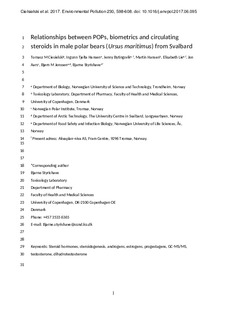| dc.description.abstract | The aim of this study was to determine the effects of persistent organic pollutants (POPs) and biometric variables on circulating levels of steroid hormones (androgens, estrogens and progestagens) in male polar bears (Ursus maritimus) from Svalbard, Norway (n = 23). Levels of pregnenolone (PRE), progesterone (PRO), androstenedione (AN), dehydroepiandrosterone (DHEA), testosterone (TS), dihydrotestosterone (DHT), estrone (E1), 17α-estradiol (αE2) and 17β-estradiol (βE2) were quantified in polar bear serum by gas chromatography tandem mass spectrometry (GC-MS/MS), while POPs were measured in plasma. Subsequently, associations between hormone concentrations (9 steroids), POPs (21 polychlorinated biphenyls (PCBs), 8 OH-PCBs, 8 organochlorine pesticides (OCPs) and OCP metabolites, and 2 polybrominated diphenyl ethers (PBDEs)) and biological variables (age, head length, body mass, girth, body condition index), capture date, location (latitude and longitude), lipid content and cholesterol levels were examined using principal component analysis (PCA) and orthogonal projections to latent structures (OPLS) modelling. Average concentrations of androgens, estrogens and progestagens were in the range of 0.57–83.7 (0.57–12.4 for subadults, 1.02–83.7 for adults), 0.09–2.69 and 0.57–2.44 nmol/L, respectively. The steroid profiles suggest that sex steroids were mainly synthesized through the Δ-4 pathway in male polar bears. The ratio between androgens and estrogens significantly depended on sexual maturity with androgen/estrogen ratios being approximately 60 times higher in adult males than in subadult males. PCA plots and OPLS models indicated that TS was positively related to biometrics, such as body condition index in male polar bears. A negative relationship was also observed between POPs and DHT. Consequently, POPs and body condition may potentially affect the endocrinological function of steroids, including development of reproductive tissues and sex organs and the general condition of male polar bears. | nb_NO |

